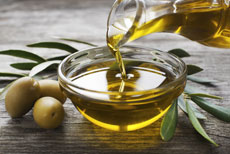
Tip: Learn how to choose among the many different cooking oils available for nourishing food that tastes great!
By the Chef Marshall O’Brien Group
The cooking oil section of your grocery store may leave your head spinning with the overwhelming number of choices. Healthy fats and oils are essential for overall health, absorption of nutrients and delicious-tasting food, but it can be difficult to know which support your health and which you should avoid. By understanding what to look for in a healthy oil and which are best for different cooking purposes, you can avoid the confusion and choose oils that help your family feel their best and make great tasting food!
The Good, The Bad and The Ugly
Certified organic extra-virgin olive oil should be your “go-to” oil for most uses. Certified organic expeller-pressed canola oil is an excellent choice for baking. Oils that are cold- or expeller-pressed are generally higher in nutrients and antioxidants. Use this list of our favorite oils – and some to avoid – to help you choose the best oils for your family:
Good Oils include:
- Extra-virgin olive
- Coconut
- Expeller-pressed canola
- Safflower
- Grapeseed
- Sunflower
- Avocado
- Flaxseed
Oils to Avoid include:
- Soybean
- Corn
- Palm
- Cottonseed
What Makes an Oil Good or Bad?
Oils are composed of different types of fatty acids that have different impacts on your body and health. No oil is exclusively composed of one type of fatty acid, but many oils have higher concentrations of certain types:
- Monounsaturated fats are abundant in olive, avocado, canola, high-oleic safflower and sunflower oils; these fats may help reduce LDL (bad) cholesterol and triglycerides and raise HDL (good) cholesterol levels.
- Polyunsaturated fats include omega-3 and omega-6 fatty acids.
- Omega-3 fatty acids are abundant in flaxseed and chia seed oils; they may help lower cholesterol, blood pressure, and reduce inflammation.
- Omega-6 fatty acids are abundant in safflower, grapeseed, sunflower, wheat germ, corn, walnut and cottonseed oils. Most Americans eat more than enough omega-6s and should reduce their consumption of these fatty acids.
- Saturated fats are abundant in coconut, palm kernel and fully hydrogenated oils. The Dietary Guidelines for Americans recommends you consume less than 10 percent of your calories from saturated fats; however, certain types, like lauric acid found in coconut oil, may not have the negative health effects of other saturated fats.
- Trans fats should be avoided entirely. These bad fats are abundant in any oil that is “partially hydrogenated”; they raise bad cholesterol and lower good cholesterol levels, while increasing your risk of developing heart disease, type 2 diabetes and stroke.
Choose the Right Oil for Your Cooking
When choosing an oil, consider not only its nutritional characteristics, but also how well the oil holds up to heat. All oils have a smoke point temperature above which the fats begin to break down, altering the chemical structure and compromising the oil’s nutrition. Even a ‘good’ oil can turn ‘bad’ if heated above its smoke point or allowed to go rancid:
- Low- to medium-heat cooking – Use extra-virgin olive oil, organic expeller-pressed canola oil or coconut oil for low, moist-heat cooking methods like braising, stewing, steaming and poaching.
- High-heat cooking – Choose an oil with a high smoke point, like avocado, sunflower or refined organic expeller-pressed canola oil, for searing, deep-frying and stir-frying. Use spice rubs instead of marinades when grilling.
- Dressings and dips – Oils high in monounsaturated fats, like extra-virgin olive oil, or omega-3 fatty acids, like flaxseed oil, are ideal for non-heat cooking and salad dressings. Try Chef Marshall’s Garden Chicken-Quinoa Salad with one of its three dressings: Lemon-Chive, Dill-Dijon and Ginger-Miso Vinaigrette for irresistible salads that highlight the flavor and nutrition of these healthy oils.
Good Oils Gone Bad
Even when you start with a “good” oil, exposure to light and heat can transform it into a “bad” oil by altering its chemical structure and turning it rancid. Store oils in a tightly capped bottle in a cool, dark place. Some oils, including flaxseed oil, are best stored in the refrigerator. Use oils only once, and avoid heating them above their smoke point.
Use Oils Wisely
Oils add essential nutrition and flavor to the foods you eat. Understanding which oils support your health and when to use them helps you prepare foods that are not only delicious, but support your wellness. Stock your pantry with a variety of healthy oils for all your cooking needs.
You will love the way you feel!
 The Chef Marshall O’Brien Group is a dedicated assembly of professionals based in Minneapolis, Minnesota, committed to the goal of using nutrition to get kids and families to lead happier, healthier lives.
The Chef Marshall O’Brien Group is a dedicated assembly of professionals based in Minneapolis, Minnesota, committed to the goal of using nutrition to get kids and families to lead happier, healthier lives.